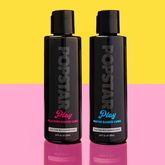The Thera Wand is a specialized tool designed to help individuals address pelvic floor tension and discomfort through targeted, gentle pressure. While often discussed in the context of women’s health, many men experience pelvic floor issues and can benefit from using a Thera Wand to support relaxation, improve blood circulation, and potentially alleviate certain pelvic-related problems. In this article, we’ll explore this device in depth—covering its purpose, how it works, tips for safe and effective use, comparisons with other tools, and answers to common questions about its role in men’s health.
Table of Contents
- What Is a Thera Wand?
- Why Is a Thera Wand Important in Men’s Health?
- How Does a Thera Wand Work?
- Who Can Benefit from Thera Wand Usage?
- Tips for Effective Thera Wand Use
- Comparisons to Other Pelvic Health Tools
- Professional Guidance vs. Self-Help
- Potential Side Effects and Precautions
- Frequently Asked Questions
- Conclusion
What Is a Thera Wand?
The Thera Wand is a therapeutic device designed with a curved, ergonomic shape, allowing users to reach and massage deep muscle layers in the pelvic region. Often constructed from body-safe materials such as medical-grade plastic or silicone, the Thera Wand facilitates gentle pressure on tight or overactive muscles. Traditionally, pelvic floor specialists may recommend this wand to individuals experiencing muscular imbalances or chronic pelvic pain. These imbalances can be tied to stress, injury, or postural issues that affect the core and pelvic floor.
Pelvic floor muscles play a crucial role in supporting various organs and contributing to functions such as bladder control, bowel regulation, and sexual health. When these muscles are too tight or strained, it can result in discomfort, pain, and compromised quality of life. A Thera Wand helps address tension points—often referred to as trigger points—where knotted muscle fibers may cause localized or referred pain. By carefully massaging these points, users may improve blood circulation, reduce inflammation, and enhance overall pelvic function.
While the design varies among manufacturers, the core principle remains the same: to enable self-administered myofascial release or assist a healthcare professional in performing targeted therapy. Many men find that the Thera Wand is beneficial for addressing lower back discomfort, hip pain, or tension that radiates into the groin and perineal region. By incorporating a device explicitly crafted for deep muscle release, individuals gain better control over their self-care routine, potentially enhancing both physical comfort and holistic well-being.
Why Is a Thera Wand Important in Men’s Health?
Although pelvic floor health topics are often geared toward women, men can also suffer from tightness, spasms, or dysfunction in this region. Issues such as chronic pelvis pain, lower back discomfort, or certain types of erectile challenges can sometimes be rooted in muscular imbalances. The Thera Wand offers a direct method for men to address specific muscle tension and trigger points around the pelvic region, facilitating relaxation and relief.
Beyond discomfort, an overlooked reason for men to prioritize pelvic floor care is its potential influence on sexual health. The pelvic floor muscles contribute to erection quality, ejaculation control, and overall sexual performance. When these muscles are strained or knotted, it can negatively impact sensation and function. By easing tension and improving blood flow, the Thera Wand may indirectly support better sexual experiences.
Another important consideration is recovery from injuries or surgeries. Men who have undergone procedures involving the prostate or lower abdomen may experience scar tissue formation or inflammation around the pelvic floor muscles. Skillful use of a Thera Wand under medical guidance can help break down adhesions and relieve painful spots. Additionally, athletes who engage in high-impact sports like running, basketball, or weightlifting place repetitive stress on the core and pelvic region, leading to stiffness or aches. In these scenarios, a Thera Wand can be a proactive measure to manage muscle tension and prevent chronic issues from developing.
Ultimately, making the Thera Wand a part of men’s health routines can be about more than just symptomatic relief. It encourages listening to the body’s signals, addressing pain points before they escalate, and promoting a healthy, flexible muscular system in a part of the body often ignored until discomfort arises.
How Does a Thera Wand Work?
The Thera Wand is used for trigger point therapy and myofascial release, two approaches common in physical therapy and rehabilitation. Trigger point therapy targets hyper-irritable spots within tight muscle bands. When pressure is applied, it can release built-up tension, reduce pain, and allow muscles to regain normal elasticity and function. Myofascial release focuses on the fascia, the connective tissue enveloping muscles, helping reduce restrictions that may cause stiffness or impede mobility.
Mechanically, the Thera Wand applies consistent, controlled pressure to an irritated area. This can decrease localized swelling and enhance blood circulation. Better circulation facilitates the delivery of oxygen and nutrients to muscle fibers while removing metabolic waste—an essential aspect of recovery. Over time, this regular, strategic massaging action helps foster a more balanced muscular environment. For men, specifically targeting the layer of muscles surrounding the prostate or near the perineum can be instrumental in mitigating discomfort and re-establishing normal muscular tone.
For best results, many users employ a slow, methodical approach. Rather than forceful digging, gentle, sustained pressure is applied for a short period—often 60-90 seconds—until the muscle begins to relax. After releasing tension in one spot, the wand is repositioned to address adjacent areas. Proper lubrication and a comfortable position—such as lying on one’s back or side—can support better control and more efficient contact with muscle tissue. Since consistency is key, short but regular sessions allow gradual improvements in flexibility, range of motion, and relief from nagging pain, making the Thera Wand a valuable component of a well-rounded pelvic health regimen.
Who Can Benefit from Thera Wand Usage?
Numerous men with varying backgrounds and health conditions may find a Thera Wand advantageous. Individuals with chronic pelvic pain syndrome (CPPS) or prostatitis commonly experience discomfort rooted in muscle tension. Men who struggle with recurrent tension in the lower back, buttocks, or groin area may also discover that targeting the pelvic floor muscles provides sought-after relief. This is especially true for men with physically demanding lifestyles or athletes who regularly stress their core and pelvic region during high-intensity training.
Office workers or those with predominantly sedentary jobs are another subgroup who can benefit. Long hours spent seated place prolonged stress on the hips and lower back, frequently resulting in tightness or muscle knots that can radiate pain to the pelvic floor. By integrating Thera Wand sessions into a weekly self-care routine, these individuals can proactively counteract the detrimental effects of chronic sitting and improve posture-related strains in the pelvic region.
Additionally, men who have undergone certain surgeries—such as prostate removal or hernia repairs—may be advised to consider gentle pelvic floor therapy to optimize healing. Scar tissue or post-operative inflammation can cause painful adhesions. The Thera Wand, when utilized correctly, can help minimize localized discomfort. However, it’s imperative to consult a healthcare professional or pelvic floor physical therapist if there are concerns about surgical complications or contraindications for internal or external massages. Confirming medical suitability ensures that Thera Wand use integrates safely and effectively into individualized recovery protocols.
Tips for Effective Thera Wand Use
Employing the Thera Wand effectively involves careful preparation and attention to detail. Here are some guidelines for maximizing its benefits:
- Preparation: Before inserting or applying the wand, trim your nails, wash your hands, and find a clean, comfortable space. Warm showers or gentle stretches beforehand can loosen tight muscles, making the therapy session more effective.
- Lubrication: Using a water-based lubricant can reduce friction and assist in a smoother glide, especially if the Thera Wand is used internally. Avoid any oil-based or silicone-based products that could degrade certain wand materials.
- Positioning: Many individuals lie on their back with knees bent, while others prefer side-lying or a reclined seated position. Comfort and stability are the primary aims; being relaxed can make a noticeable difference in the outcome.
- Breathing Techniques: Deep, diaphragmatic breathing helps the pelvic floor relax. Inhale through the nose, filling the abdomen, and exhale slowly through the mouth. Synchronizing the application of pressure with each exhale can help mitigate discomfort.
- Gradual Pressure: Focus on gently easing the wand into identified tension points. Overly forceful pressure can cause additional muscle guarding or irritate sensitive tissues. Instead, utilize steady, moderate force until you feel muscle release.
- Short Sessions, Consistent Practice: Aim for multiple short sessions during the week rather than infrequent, longer sessions. This consistent approach helps the body adapt gradually, minimizing potential irritation or soreness.
- Post-Session Care: After using the wand, gently stretch the lower back and hips or take a warm bath. Hydration and light movement can support muscle recovery and enhance circulation.
Always listen to your body throughout the process. If at any point you experience acute or worsening pain, stop and consult a physician or physical therapist. Paying close attention to signs of excessive strain helps ensure that using the Thera Wand remains both safe and beneficial.
Comparisons to Other Pelvic Health Tools
The Thera Wand is one of several devices marketed for pelvic floor therapy, muscle release, or general wellness in the lower abdomen. Other tools might include foam rollers, massage balls, and different shapes of pelvic wands. Each piece of equipment comes with its set of advantages and limitations, and the best choice often depends on personal comfort, ease of access, and specific health goals.
For instance, foam rollers are excellent for targeting large muscle groups such as the back, hamstrings, and calves but may not have the nuanced curve or targeted reach needed for precise pelvic floor work. Spiky massage balls can be effective for general muscle tension but are less ideal for internal or targeted pressure in sensitive zones. Low-profile handheld massagers might offer some convenience, but the compact design of a Thera Wand helps users reach deeper tissues with more control.
In addition to these self-help instruments, professional treatments like physical therapy sessions or specialized trigger point injections are also available. While professional interventions may speed up recovery under direct supervision, they can be costly and time-dependent. The Thera Wand, on the other hand, allows a hands-on, do-it-yourself approach that suits many lifestyles. Ideally, one might blend professional guidance with at-home wand usage, striking a balance between specialized oversight and personal empowerment.
Professional Guidance vs. Self-Help
The Thera Wand is often championed as a self-help tool, but it’s wise to acknowledge the value of professional guidance. Pelvic floor physical therapists undergo specialized training to identify the root causes of pelvic discomfort. They can pinpoint tight muscles, posture deficits, or underlying conditions that may impact the efficacy of self-directed treatments. An initial consultation or series of sessions with a pelvic health expert can teach proper wand insertion angles, optimal pressure application, and recommended session duration.
While many users are comfortable adopting Thera Wand therapy on their own, men with complex pain profiles, post-surgical complications, or significant muscle imbalances may benefit from structured care plans. Professionals can tailor interventions, ensuring that the wand use compliments other recommended exercises and therapies. Regular check-ins can also help track progress, refine techniques, and prevent potential misuse that might exacerbate existing discomfort.
On the other hand, self-help approaches offer flexibility and privacy—key considerations for many who may feel uncomfortable discussing sensitive pelvic concerns. This independence can help users maintain a routine on their own schedule, responding to muscle tension as soon as it arises. By blending professional guidance with consistent at-home exploration, many men forge a path that supports long-term pelvic health and comfort.
Potential Side Effects and Precautions
Although the Thera Wand is generally viewed as safe, there are a few essential precautions. Overly aggressive use can aggravate pelvic floor tissues and potentially intensify pain. It’s crucial to remember that slow, controlled movements are more effective than rapid or forceful applications. Serenity during sessions—achieved through breathing exercises and a calm environment—helps ensure that muscles relax rather than resist the pressure.
Certain medical conditions may require specialized consideration. Men dealing with active infections, open wounds, or healing incisions in the pelvic region should seek professional clearance before using the Thera Wand. Likewise, anyone with severe hemorrhoids or rectal fissures should be cautious about internal usage. If you experience unexplained bleeding, sudden severe pain, or dizziness, discontinue usage and consult a medical professional.
The presence of scar tissue or nerve hypersensitivity may demand a gentler approach or shorter initial sessions. Those taking medications that influence pain perception or circulation might discover their tolerance for pressure feels different. Partnering with a healthcare provider or physical therapist to develop a personalized plan is key if there are any doubts about the suitability of this therapy. Ultimately, user awareness and adherence to safe practices pave the way for a positive experience with minimal risks.
Frequently Asked Questions
Is the Thera Wand only for internal use?
No, the Thera Wand can be utilized both internally and externally. Many men find external application beneficial in relieving tightness around the perineum or the lower abdomen. Internal use is typically recommended if a healthcare professional or a pelvic floor therapist has confirmed the presence of tender points or knots that can best be addressed internally. Whether internal or external, it is vital to use proper lubrication and proceed gently.
How often should I use the Thera Wand?
The frequency of use can vary, but most beginners start with one to two sessions per week, lasting about 10 to 15 minutes each. As you become more experienced, you can adjust the frequency based on your comfort and therapeutic goals. Overusing the wand—especially at first—may result in temporary soreness or irritation. Gradual progression often yields the best long-term results, allowing your body to adapt and respond positively to targeted pressure.
Can the Thera Wand help with erectile dysfunction (ED)?
While the Thera Wand is not a direct cure for erectile dysfunction, improving pelvic floor health can sometimes enhance overall sexual function. Chronic tension in the pelvic region may contribute to blood flow restrictions or discomfort that can interfere with arousal and erection quality. Releasing tension may improve circulation and bodily awareness, indirectly supporting healthier erectile function. However, ED can have numerous causes—including hormone levels, vascular factors, or psychological aspects—so a comprehensive approach is often recommended.
Is it painful to use a Thera Wand?
Some mild discomfort or a sensation of pressure can be normal, especially when targeting tense muscles or trigger points. However, usage should never cause sharp or unmanageable pain. If the discomfort escalates beyond mild tension, reduce pressure or switch positions. Breathing exercises (inhaling deeply and exhaling slowly) can also mitigate pain and help ease you deeper into muscle release. If persistent pain occurs, consult a pelvic floor specialist to reevaluate your technique or determine any underlying issues.
Do I need medical supervision to start using a Thera Wand?
Although it is not always mandatory to have a prescription or direct medical oversight, seeking professional advice can be beneficial if you have specific concerns. A pelvic floor physical therapist or knowledgeable healthcare provider can demonstrate correct methods, advise on session frequency, and identify any potential contraindications. This guidance is especially invaluable for individuals with complex medical histories, recent surgeries, or unresolved pelvic injuries.
Can regular Thera Wand use prevent future pelvic issues?
Preventive measures are indeed part of holistic pelvic health. Consistent muscle care and periodic check-ins with a Thera Wand can help maintain supple, strong pelvic floor muscles. This proactive approach may reduce the likelihood of nagging pains or injuries tied to muscle imbalances or tension. However, prevention also involves other lifestyle factors—like staying active, maintaining good posture, managing stress, and practicing safe exercise techniques. The Thera Wand can be a useful piece of a comprehensive pelvic health puzzle.
Are there any age restrictions for using a Thera Wand?
There is no strict age restriction. Men across a wide spectrum of ages might use a Thera Wand if they experience muscle tension or wish to support pelvic well-being. Nonetheless, younger individuals dealing with sports injuries or high stress might see benefits earlier in life, while older adults might use it to alleviate chronic discomfort or maintain mobility. In any case, consulting with a healthcare provider ensures that the Thera Wand aligns appropriately with each individual’s medical context.
Is a Thera Wand different from a prostate massager?
While both tools may have similarities in shape and the general region they target, a Thera Wand is specifically designed for myofascial release and trigger point therapy within the pelvic floor muscles. Prostate massagers tend to focus more directly on prostate stimulation. Although certain angles of the Thera Wand may indirectly apply pressure to the prostate, its primary intent is muscular release and tension relief. Choosing one tool over the other often depends on the type of pelvic health objective—muscle relaxation versus direct prostate massage—you aim to achieve.
Conclusion
The Thera Wand offers a highly targeted approach for men seeking to address pelvic floor tension, manage chronic pelvic pain, and maintain overall muscle health within the lower abdomen. By honing in on trigger points, enhancing blood circulation, and promoting relaxation, it can be an integral part of a broader men’s health strategy. While self-use is empowering and convenient, seeking initial guidance from a professional can ensure the technique is safe, effective, and properly aligned with individual needs.
As with any wellness regimen, consistency and mindfulness are central to achieving meaningful results. If you find that pain persists or if your condition worsens, be sure to consult a healthcare provider for an in-depth evaluation. Ultimately, the Thera Wand stands as a valuable tool—one of many—that helps men foster a healthier, more resilient pelvic floor, improving both comfort and quality of life in the process.


































